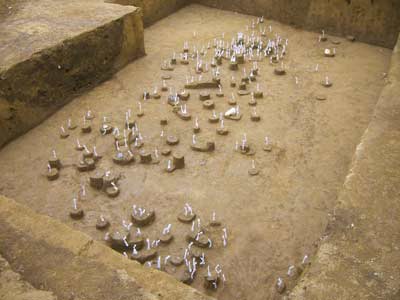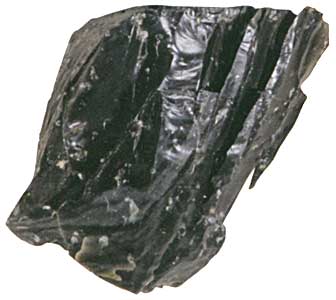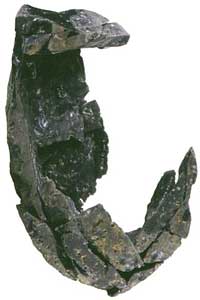Nakahigashi:
A campsite found in a buried river basin. The stone blade
manufacturing technique of 30,000 years ago comes to light.
Nakahigashi Site, Miyoshi Town, Saitama Prefecture
A site in an unlikely location
In the Paleolithic era, it was colder and drier than the present day. Because people lived in camps along rivers, or at places where water gushed out from under a cliff, hoping to catch animals drawn there, most of the sites lie along small streams of tablelands.
But from the Nakahigashi site, located on the northeastern part of the Musashino Terrace at a place with no river today, traces were found of the manufacture of many stone tools from materials such as obsidian.
The age of the site (from ca. 30,000 to ca. 19,000 years ago) places it in the Upper Paleolithic Era. Since 1992, as the result of analysis of contour lines, and geological surveys conducted in addition to archaeological investigations, it has become clear that a river formerly flowed in this area, which at present is level and has no river, and in the vicinity there are multiple sites from the same period. A new perspective has thus opened for future investigations of Paleolithic sites. (Echizenya Tadashi)
The Tachikawa loam layer which yielded stone tools
More than 3,300 items of stone tools and small stones have been recovered from both banks of the buried river at the Nakahigashi site. The stone tools are from approximately 30,000 (Tachikawa loam, Layer IX) to 19,000 (Layer III, upper portion) years ago, and come from every soil layer. In addition to knife-shaped stone tools of obsidian used in hunting, end- and side-scrapers for butchering game have been found, and now it is clear that over a long span of approximately 10,000 years, people repeatedly came to this spot, time and again making tools and hunting, butchering and cooking, while living a camp life.
Obsidian brought from afar
Of the 1,369 obsidian stone tools recovered from soil layers of about 30,000 years ago, roughly 87 percent were produced with obsidian from the Kashiwa pass, near the Mount Amagi volcano on the Izu peninsula, and others are also known from Hatajuku along the Sukumo river of Hakone, and the Wada pass in Nagano prefecture.
Among these are multiple examples of stone tools of material from the Kashiwa pass and Hatajuku which can be refitted into shapes close to the original stone. From these refitted materials, the technology of approximately 30,000 years ago for taking long flakes and using these to produce knife-shaped stone tools, is coming to light. (Ōkubo Jun)






